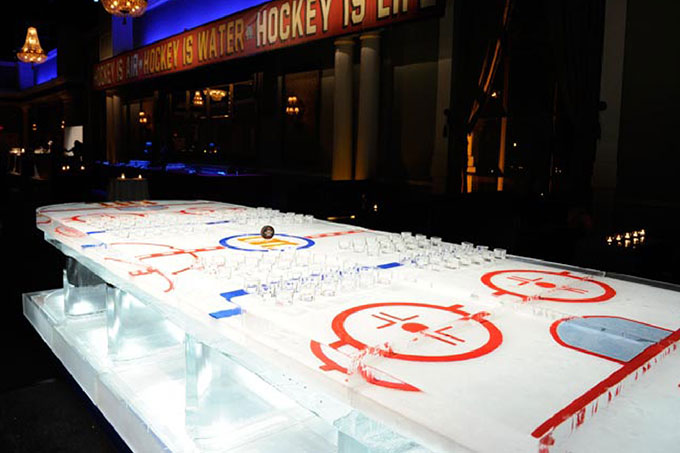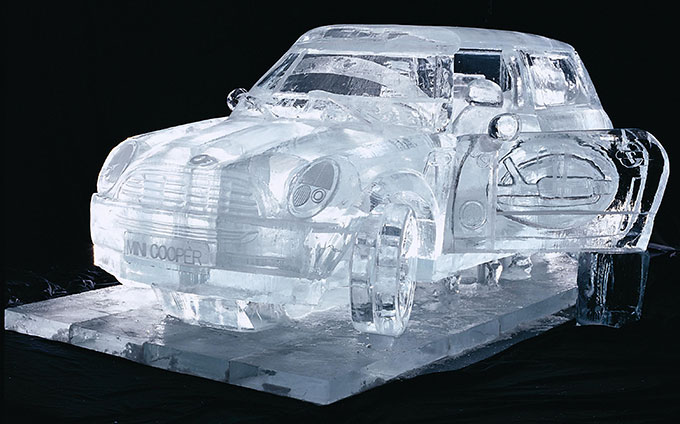Iceculture, Inc. is one of the world's largest ice carving companies with a staff of 50. In the past, the company designed its creations in the traditional way, by hand, and then cut and assembled ice blocks to form the final project. More recently, Iceculture has invested in ArtCAM software, which is used by its team of designers to define the complete ice sculpture as a computer model. The model is later converted to computer numerical control (CNC) code that drives an ice router to create each of the pieces needed to bring the designer's conception to life. "ArtCAM Pro helps us deliver a more consistent product in a fraction of the time required in the past," said Sam Bayley, Production and Plant Manager with Iceculture, which is based in Hensall, Ontario.

Iceculture was founded by Julian Bayley and his late wife Ann in 1989 with a single machine the size of a dishwasher that could turn out two ice punch bowls every seven days. The company has grown based largely on technical innovation. For example, Bayley worked with a colleague in the ice business and a router manufacturer in Calgary to develop a CNC ice router for cutting ice in the late 1990s. And it dramatically reduced the time needed to produce ice sculpture designs. He also designed his own ice lathe, which shapes blocks of ice into spheres and cylindrical objects such as footballs, pillars, wine bottles and vases.

Iceculture produces crystal clear blocks of ice in a machine that freezes ice from the bottom up, forcing bubbles and impurities to the surface where they are siphoned off when the blocks are harvested. The blocks not used in the company's freezer studio are shipped around the world to customers as far away as Australia, New Zealand, Europe, Dubai and Greece.
One of the company's higher profile projects involves providing 3D ice sculptures, ice furniture, ice lounges and other items to the Toronto Film Festival. Most years a major event is based around the winner of the film festival and Iceculture is often asked to provide one or more ice sculptures for the event. For example, a film about ice hockey recently won the top award and Iceculture produced a 20-foot-long and 9-foot-wide hockey rink made entirely of ice as a focal point at the event. The ice rink included logos of the corporate sponsors, holes and hatches for shot glasses, table space for served food and many other features.
The traditional approach to ice carving is to draw a template that shows the profile of the sculpture and provide the carver with a guide for including details of the design that need to be made on each block of ice. This approach is in itself very time-consuming and one in which it's difficult to maintain the accuracy required to produce quality results. The next step is to glue each template onto a block of ice and remove excess ice with a chain saw and cut out the holes, hatches, logos, etc. with chisels and hand power tools.
This can also be tedious and is even prone to inaccuracies. The potential for misalignment often calls for additional manual work when assembling the blocks at the job site.
The combination of ArtCAM Pro and CNC ice routers has enabled Iceculture designers to implement more efficient methods that also produce more accurate and higher quality finished products. "We started working with ArtCAM when our business was very young," Sam Bayley said. "One of the first benefits we saw was the software's ability to help us replicate corporate logos quickly and accurately." Logos are a very important part of our business. When logos were cut using large photocopies as templates, imperfections were an inevitable part of the process. ArtCAM easily converts bitmap logos provided by sponsors into a vector file that can in turn be converted into a CNC toolpath to drive an ice router.

In the case of the hockey rink, Cate McDonald, one of Iceculture's designers, took measurements from an actual hockey rink that the ice version was based on. She drew the rink in 2D in ArtCAM and scaled it down to fit the size of the ice sculpture. She created a standard size ice block and copied it several times. She tailored the ice blocks to the basic rink design. The rink itself incorporated many holes used to hold shot glasses. McDonald created these holes by using the double block rotate copy feature of ArtCAM. "I specified that I needed a 1-1/4 inch diameter hole, how many rows and columns I wanted, the offset between the rows and columns and the minimum gap between the holes," McDonald said. "The software then automatically generated a pattern that filled the space with the maximum number of holes while following the rules I provided." McDonald made a few adjustments to the parameters in order to improve the appearance of the hole pattern and each time the software regenerated it in seconds according to her new specifications.
Iceculture has upgraded to ArtCAM Pro, which provides a wide range of new capabilities such as the ability to design and build 3D contoured surfaces. This capability came in handy on several recent film festival projects. In one case the sponsor of the event was a large software drink manufacturer so Iceculture was commissioned to build an ice sculpture about eight feet high that replicated a famous soft drink bottle. Producing a sculpture of this complexity using manual methods would have taken a long time and it would have only been possible to produce an approximate likeness of the bottle. Iceculture designers imported a 3D model of the bottle into ArtCAM. They simplified the model, divided it into blocks of ice and then generated toolpaths to cut each block with an ice router. The result was stunningly accurate 3D representation of the original bottle.

Matt White, CNC Programmer for Iceculture, designed a 3D ice carving of a swan. He started with a 2D bitmap that he imported into ArtCAM. He converted the bitmap into a vector model and then divided the various sections of the model such as the head, wings, body and neck into a total of 50 different features. "Once I have created a feature, I can easily do different things with it such as copying, resizing, moving, etc.," White said.
He used ArtCAM's two-rail sweep feature to convert the head, neck and wing into 3D. Then he used sculpting tools such as "smooth" and "smudge" to blending the resulting 3D shapes together. "Using the smooth tool is as simple as clicking on the surfaces that you want to blend together," White said. "The smudge tool, on the other hand, enables the user to adjust surfaces manually." White saved time by first creating the right half of the swan and creating a mirror image to complete the swan. Finally, he used ArtCAM to produce CNC toolpaths used to produce the swan on the ice router.
ArtCAM provides an excellent tool to design beautiful objects and produce them on ice routers in a fraction of the time that is required using manual methods,"

For more information about Ice Culture please go to http://www.iceculture.com
